Networking global agro-eco health projectsCase studies from Kenya, Myanmar and the Philippines-
Date: 05 March 2009
Venue: P-K Hall, Obihiro University of Agriculture and Veterinary Medicine
13:00-15:00
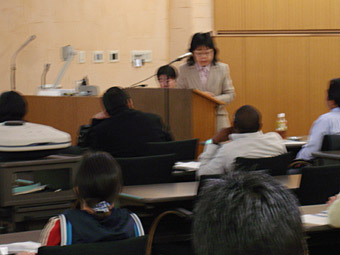
- Chairman of the first session: Mutsuyo Kadohira

- Prof. Kawazu, Team leader, told us objectives of the workshop.
Case study 1
An ecosystem Health study of the Kiambu Tropical Highlands agro-ecosystem,Kenya
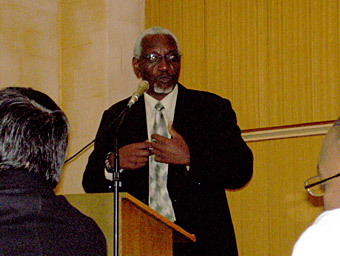
- Prof. E. Kang’ethe (University of Nairobi,Kenya)
Abstract
A process was designed to assess the health and sustainability of a tropical-highland, smallholder-dominated agroecosystem. Twelve study sites within the agroecosystem were selected in a multistage, purposive sampling protocol. Six of the study sites were designated “intensive” (ISS). In these, some agroecosystem health and sustainability remedial measures were instituted. The other six study sites were designated “extensive” (ESS) and were used to cross-validate the indicators and to provide statistical power.
Communities in the ISS were included in the health and sustainability assessment. Participatory action-research methods were used for that purpose. Relationships among agroecosystem and sustainability factors were explored using loop models, graph theory among others. Two sets of health and sustainability indicators were developed. One set – the community driven suite of indicators. These indicators were used to develop a community-based agroecosystem health and sustainability monitoring system.
Although the process used in this study was similar in some ways to traditional approaches in research and development, there was an important departure in that communities were part of both the problem-definition and the analytical processes. In addition, the entire process was grounded in a unifying theoretical background that facilitated a holistic analysis. More important, however, is that communities were able to use the concept of health to discuss and model approaches to better their livelihoods. The approach provided a simple, yet highly specialized language – understood by the communities, researchers, extension agents, development agents and policy makers – for discussing issues of health and sustainability of agroecosystems and for structuring the process through which remedial actions could be undertaken.
Case study 2
Overview of ADRA’s agro-ecosystem health prohects in Myanmar
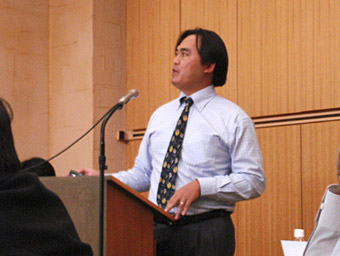
- Mr. Kyaw Aung(Programs Manager,ADRA Myanmar)
Case study 3
Epidemiology and control of Schistosomiasis in the Philippines
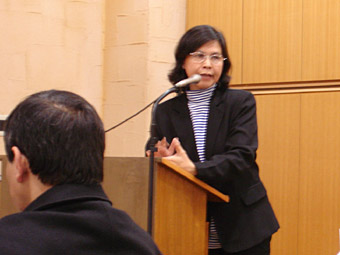
- Prof. P. Tongol-Rivera(University of Phillippines Manila,Philippines)
Abstract
Schistosomiasis japonica is endemic in 28 provinces in the Philippines. These provinces cover almost all of Mindanao, the eastern part of the Visayas and only 3 provinces in Luzon. The most recent prevalence survey of schistosomiasis was conducted by a team composed of members from the College of Public Health, University of the Philippines, Manila, the National Mapping and Resource Information Authority, the Department of Health and the World Health Organization. This national baseline prevalence survey on the disease was done in 2005, in Mindanao, 2006 in Visayas and 2007 in Luzon. It utilized stratified two-stage systematic cluster sampling, with all provinces being stratified by the region they belong to, and by their past schistosomiasis prevalence rates (high, moderate, low). The province was the primary sampling unit, and the barangay (village) as the secondary sampling unit. The households from which the subjects belong were selected by systematic sampling. A total of 274 subjects per village, 5 villages per province, were included in Mindanao, 356 subjects in Visayas and 100 subjects in Luzon. Only Maguindanao in Mindanao was not able to join the survey. Microscopic examination of 2 stool samples using the Kato-Katz method was done for each subject. Eggs of Schistosoma japonicum, and other intestinal helminthes like Ascaris lumbricoides, Trichuris trichiura, hookworm, heterophyid and echinostome flukes were detected. The prevalence rates were computed by dividing the number of positives by the total number examined.
The results showed that schistosomiasis prevalence was highest in the following provinces: Agusan Sur, Surigao Sur, Bukidnon, Lanao Norte and Davao Norte in Mindanao, Northern and Eastern Samar, Samar and Leyte in the Visayas, Mindoro Oriental in Luzon. Schistosomiasis was more prevalent among males than females. Among the age groups, the older ones showed higher schistosomiasis prevalence. Tables, graphs and maps showed the details of these results.
This prevalence survey confirmed the endemicity of schistosomiasis in these provinces where much rainfall and flooding favor human-parasite contact and higher transmission. The higher prevalence among older and working age groups is consistent with occupationally related exposure to the infective stages. The results also showed focal distribution, which is so characteristic of climate-sensitive and vector-borne diseases like schistosomiasis. Other intestinal helminths were also found to be highly prevalent and co-existent with schistosomes. It is because of these considerations that more intensive local surveys should be done to identify the “hot spots” of high transmission so that mass chemotherapy will be focused to these areas, while selective chemotherapy to low prevalence areas. This can be done through integrated helminth control. The other strategies such as environmental sanitation, snail control and health education can also be better planned and implemented with availability of reliable prevalence data.
15:30-17:00
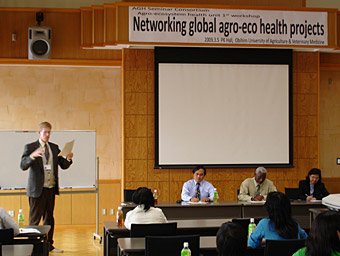
- Chairman for discussion: Marshall Smith Panelists: Mr. Kyaw Aung Oliver, Prof. Erastus K. Kang’ethe, Prof. Pilariatan N. Tongol-Rivera
Discussion sessionDefinition of Agro-ecosystem: Agro-ecosystem is a multidisciplinary approach to health improvement.
3 Pillars/ Objectives
(i) To identify areas/projects for collaboration
(ii) To draft multidisciplinary teaching modules (for training Obihiro University students and students from developing countries)
(iii) To identify ways in which Obihiro university can contribute to Agro-ecosystems projects in other countries (by direct cooperation, training local and international students)
Discussion – Questions and answers:
Q1. What is the involvement of politicians/government in agro-ecosystems projects?
Responses from the panel:
(a) The NGOs/researchers have to decide when to strategically involve the government officials during the implementation of the projects.
(b) The NGOs/researchers get authorization and approval of the project from different spheres of the government i.e. national, district and municipal level before the commencement of the project.
(c) It is also advisable to discuss the outcomes of the project with the community, its leaders and government officials in order that they can be part of necessary interventions.
(d) Based on the outcomes of the project the government officials can play a role in terms of policy establishment or policy change where necessary in order to enhance further improvement of community projects or community livelihoods.
Q2. What is the role that biotechnology can play in ecosystems?/ Can biotechnology be applied positively in ecosystems e.g. genetically modified agricultural food products?
Responses from the panel:
(a) From a medical point of view it is important that human safety from biotechnological products should be thoroughly investigated and confirmed before use.
(b) Effects of biotechnological products on the environment should also be thoroughly investigated before use. For example, biotechnological reagents aimed at improvement of agriculture should not be toxic to the environment. Furthermore care should be taken to ensure that genetically modified crops will not result in elimination of naturally occurring crop species.
(c) There should be guidelines for proper use of biotechnological products in order to safeguard the natural ecosystem.
Q3. How are the effects of agricultural projects on the ecosystem or their impacts on changing people’s lifestyles evaluated?
Responses from the panel:
(a) Agricultural projects are mostly aimed at poverty alleviation by improving/increasing food production, milk yields and general livelihood of the communities. Therefore at the end of the project improvement should be usually observed in increased production of the above-mentioned resources necessary for survival.
(b) Though not usually done, the panelists agreed that there is also need to set up mechanisms of post project evaluation which should be conducted for a period of years after the completion of the project in order to monitor the real effect of the project in changing the livelihood of the communities.
Q4. How can veterinarians participate in projects aimed at control of zoonotic diseases which mainly affect humans?
Responses from the panel:
(a) In the case of schistosomiasis, the veterinarian’s role is to collect stool samples from carrier animals and send them to the lab for analysis.
(b) In ADRA projects, veterinarians play a role of teaching trainees who would in turn be trainers on animal diseases and husbandry.
Q5. How do you motivate those who are trained for specific skills in the projects to pass on the skills to other people in the community and other villages?
Responses from the panel:
(a) For ADRA’s community project in Myanmar, the community members, who have received training for certain skills from the project, usually get monetary compensation for transferring their acquired skills to other community members or to other nearby villages. One ADRA project has so far reached 30% skilled community members in a period of two years.
(b) For the project in Kenya, the organizers encourage the trainees in the community to pass on their acquired skills to other community members or other villages by motivating and showing them the importance of the projects in the community and that the transfer of skills is for the benefit of all members of the community/village.
Q6. Despite the role of authorization and approval of the projects by the politicians/governments, what other roles do they play in projects conducted by NGOs aimed at improving people’s lives in resource poor areas?
Responses from the panel:
(a) Once again the panelists emphasized that it depends on the discretion of the NGOs/researchers to plan and formulate and decide when the right time is to involve government officials.
(b) Panelists mentioned that it is advisable that organizers – be it NGO or researcher – involved in community projects should always try to establish good contacts and a good relationship with government officials in areas where they are conducting the projects, including inviting officials to social functions as this will encourage them to be more involved in projects.
(c) The Myanmar experience:
– In one instance, ADRA reached an agreement with the government in Myanmar where ADRA installed the necessary facilities for supply of water in the community targeted by the project whilst the government agreed to built a road in that village.
(d) The Kenya experience:
– Government officials attended fundraising functions (harambe meetings/bazaars) as invited by community project organizers, and would even contribute financially for some projects.
– In cases where water tanks were build the government officials would always assign the government technicians and civil engineers who would assist and offer advice for building such facilities.
(e) The Philippines experience:
– There is usually a government budget for disease control which enables government officials to be involved in constituency level projects for disease management and control.
– Drugs for deworming infected people are usually bought from government budgets.
– The state veterinarians also play a role in monitoring zoonotic diseases.
– Governors also review and develop health policies for intervention depending on the outcomes of projects aimed at control of diseases, especially where communities have to change their lifestyles.
What is the criteria used to select areas/communities/villages where a project is to be conducted? Is it only based on the need for improvement of a certain community e.g. food insecurity?
Responses from the panel:
(a) NGOs/researchers should first obtain information about the needs (what the ecosystem lacks and needs for the improvement) of countries/provinces/villages, then they can decide which areas they should start a project and also decide with whom they can collaborate thereby involving other specialists.
(b) Generally the areas/communities/villages are selected for projects depending on the interests of the donors which are sometimes purely humanitarian issues or political.
(c) It is usually easier for NGOs/researchers to choose which area/ecosystem/community to conduct a community project if the project is small-scale because it will require a smaller financial donation, and usually such donors are not strict on how the donations are to be used. However, bigger projects require larger donations and the donors usually have specific wishes and areas of interest.
Q8. What kind of intervention is been applied to prevent new cases of Schistosoma infection in humans in the Philippines?
Responses from the panel:
(a) Researchers investigate which water areas are contaminated with the parasite and availability of the intermediate host.
(b) Thereafter, the community is educated to use only Schistosoma-free water areas and to avoid using contaminated water areas.
(c) Generally, communities are encouraged to change their lifestyles, for example to avoid swimming or washing or obtaining drinking water in contaminated areas.
Q9. How are lab studies linked with field studies as well as projects aimed at community life improvement?
Responses from the panel:
(a) Researchers need to develop a language of understanding which can be used to explain the outcomes of their research to a community, and what the implications are, and how to control a particular disease or avoid new infections.
(b) Linkage of lab studies and community livelihood improvement also depends on the individual will of the researchers in the lab, they need to have interest in meeting with the communities for the actual application of what has been developed in the lab.
(c) Academics should make efforts to intergrate their lab work with community needs by always meeting with government officials and the community.
(d) The university curriculum should also include community service modules, not only in the social sciences but also in the natural sciences.
General remarks
– Before starting a community project, one needs to know the traditions and culture of the targeted community.
– One of the panelists had observed that women in the communities are much more reliable in conveying (new) information (what they have learned) to other members of the community, it is therefore advisable to always make sure women participate in community projects.
– Usually start with easy and simple projects which can be easily understood by the community so that they can develop interest; and as time goes on then introduce complicated projects.
– Always have an advocacy meeting with the community and authorities and form village development committee from members of the community so that they can play a major role in implementation and monitoring of the projects.
– When dealing with diseases, after diagnosis don’t just treat it but also do further analysis of the cause e.g. is it due to environmental issues or is it due to negligence or is it due to lack of knowledge or is it due to lack of resources. Thereafter, involve different specialists, e.g. ecologists, sociologists, health (medical and veterinary) officials, politicians, economists, etc. in order to bring about what is termed trans-disciplinary approach.
- Definition of Agro-ecosystem after discussion session:
- Agro-ecosystem is a trans-disciplinary approach to health improvement.
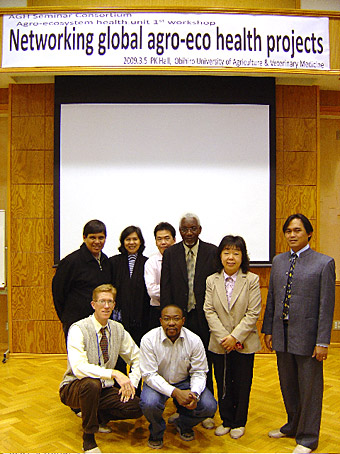
- All workshop members and Oriel, our reporter
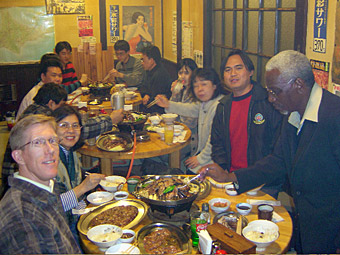
- After the 1st day, we enjoyed our get-to-gather dinner.